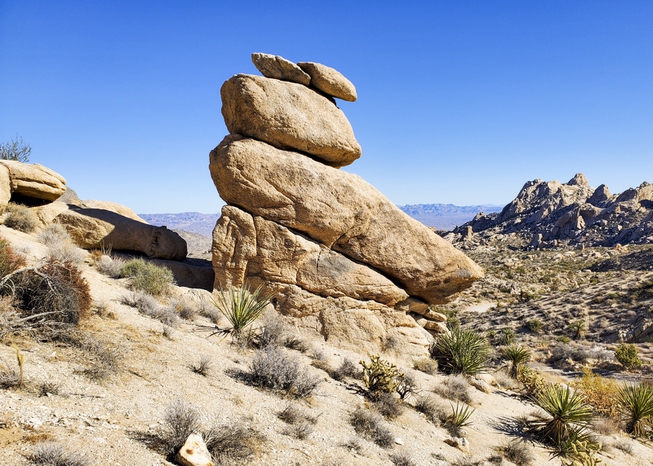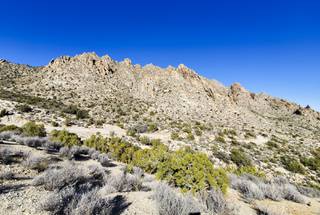
Jessica Hill
A rock formation is seen Nov. 12, 2021, in the Spirit Mountain Wilderness area in Clark County, where Avi Kwa Ame, also known as Spirit Mountain, is located. Avi Kwa Ame is a mountain and region that Native American tribes and conservation leaders are trying to protect and turn into a national monument.
Tuesday, Feb. 15, 2022 | 2 a.m.
The Clark County Commission is scheduled to vote today on whether to send a resolution urging President Joe Biden and Congress to designate 450,000 acres of land in southern Clark County as a national monument.
The area known as Avi Kwa Ame, which means “Spirit Mountain” in Mojave, is home to several Native American tribes’ creation stories and is also a popular spot for outdoor recreation.
Tribes, off-roading recreation groups and conservationists have been working for years to designate the land, located past Searchlight, as a national monument and ensure its protection.
“We have been here since time immemorial,” Timothy Williams, chairman of the Fort Mojave Indian Tribe, said during a Feb. 1 commission meeting. “(Avi Kwa Ame) means something to us. It means something deeper to us than anything else in our livelihoods will ever mean.”
Under the Antiquities Act of 1906, a national monument is a designation for public land established either by Congress or through presidential executive orders. The designation would permanently protect important values including recreation, natural and cultural resources.
The area is considered sacred by 10 Yuman-speaking tribes as well as the Hopi and Chemehuevi Paiute, said Joceyln Torres, senior field director of the Conservation Lands Foundation in the meeting. The public lands are also home to Joshua trees, petroglyphs and threatened wildlife like the Mojave Desert tortoise and the desert big horned sheep.
The Inter-Tribal Council of Nevada that represents 27 member tribes, the Inter-Tribal Council of Arizona and several town government boards have all expressed support of the monument designation.
“It lives within our heart,” Williams said. “It’s in our souls. It is the one thing that has remained consistent and persistent in these unprecedented times. It’s the one place where we can go to seek refuge in these times.”
The Fort Mojave tribe, for instance, originates from the mountain, where their Creator put them in order to steward and care for the land, said Taylor Patterson, executive director of Native Voters Alliance Nevada and member of the Avi Kwa Ame Coalition.
For other tribes, while not a part of their creation story, the mountain served as a place to gather sacred medicines and to trade with other tribes, Patterson said. The area is also part of the Salt Song Trail for Southern Paiute tribes, which tells the traditional life cycle of the Southern Paiute people, Patterson said.
“It was really a cultural site,” Patterson said.
Since 2001 Clark County has directed $2.7 million in conservation investments to the Avi Kwa Ame landscape, according to the proposed resolution, as part of the Multi-Species Habitat Conservation Plan, and the county plans to invest another $3.8 million in 2022 for habitat restoration.
Groups spearheading the effort also hope the designation would boost the local economies that tourists pass through to get to the monument.
“This has really been a piecemeal effort over the years,” Torres said. “This is our chance to connect all of those pieces and ensure there’s consistent management across the landscape.”
In the late 1990s, the mountain and its surrounding 48,000 acres were designated as a traditional cultural property on the National Register of Historic Places, but it is still in danger of development.
The designation could squash plans for future development on the land.
The Kulning Wind Energy Project proposed by Crescent Peak Renewables is a 308-megawatt project consisting of 68 wind turbines 9 miles west of Searchlight within Avi Kwa Ame. According to a survey published by the company, the project’s footprint is less than 2% of the land that the Avi Kwa Ame national monument would occupy. The company has made the argument that the land could accommodate both projects.
“The public could continue to access the land for hiking, OHV, and other recreation,” the survey says. “Rarely is there a ‘you can have your cake and eat it too’ argument in politics, but this is precisely that situation.”
City councils have announced their support to designate Avi Kwa Ame as a national monument. Boulder City Council unanimously passed a resolution in support, as well as the Searchlight Town Advisory Board. And on Nov. 9, the Laughlin Town Advisory Board voted 3-1 to support the designation of Avi Kwa Ame National Monument.
Conservationists think they have a good chance, especially with Biden’s recent restorations of Utah’s Bears Ears and Grand Staircase Escalante as national monuments as well as with the passage of the federal 30 by 30 resolution, an initiative to conserve 30% of U.S. lands and waters by 2030, said Angelyn Tabalba, communications director for the Nevada Conservation League and Education Fund.

